Notations 21 by Theresa Sauer. Mark Batty Publisher 2009. Hardcover: 320 pages. Reproduced partial images are with permission of the publisher as stated for purposes of a review of the work.
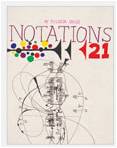
Notations 21 by Theresa Sauer is a collection of musical scores, beautifully written, drawn, painted, etched, computer generated, and so on by composers using non-traditional techniques for musical notation. Not long ago a friend was telling me about how his grandfather used to “read” musical scores at bedtime, engaged in the distraction as one might enjoy reading a short story before slumber. Another friend (with perfect pitch) describes how musical keys that contain a lot of sharps generally sound “brighter” to her. In his chapter on musical synesthesia (Ref 1), Oliver Sacks explains that for the general population the relationship between colour and music is metaphorical, but for the musical synesthete it is quite literal. What does all this have to do with Theresa Sauer’s 2009 collection of works (explorations) of musical notations? I swear there is a connection….give me a few paragraphs to figure it out with you.
Notations 21 encompasses Sauer’s research on musical notation and how the commonality “of notation comes from its purpose for the creation of music, a phenomenon that can allow for spectacular variations of musical scores” (p. 10). She solicited composers for samples of compositions with the option of including a statement or description. Some composers were also commissioned to write essays relating somehow to “notation, contemporary music, graphic scores, or the compositional process” (p. 8). The resulting 300-odd page book comprises an astounding collection of notations for musical compositions, essays on related topics, and inspirational and visual fodder for musicians and non-musicians alike. It is an exploration of the modes and media of contemporary music. The contributing composers hail from over 50 countries and diverge immensely in the style, intent, and essence of their musical notations; however they have one common thread, non of them use what we know as standard Western musical notation – although many do co-opt, distort, and subvert such notation in their own way.
The book is directly inspired by John Cage’s similar collection of the late sixties called Notations (Ref 2). In fact, it is in essence a continuation into the 21st century of the archiving process that Cage undertook to preserve 20th century notational forms. His book (co-edited with Alison Knowles) was partially conceived to benefit the Foundation of Contemporary Performance Arts and he solicited hundreds of composers, visual artists, and writers to contribute to the book (Ref 3). The selections used in the book and further manuscripts spanning the years 1884-1990 are part of the John Cage Collection in the Northwestern University Music Library (Ref 4).
I was previously unfamiliar with this endeavour of John Cage. I know of him (admittedly quite naively) as the person who influenced Yoko Ono in music and performance art, who in turn influenced John Lennon, who ultimately influenced all of contemporary pop music (and beyond). The recent exhibit at the Montreal Museum of Fine Arts, Imagine: The Peace Ballad of John and Yoko, had numerous examples of Ono and Lennon’s use of differing media apart from sound to express musical ideas. In fact Cage’s Notations book and collection include contributions from the Beatles’ canon.
The first thing I did upon opening Notations 21 was to go to Theresa Sauer’s own piece in the collection called Parthenogenesis.
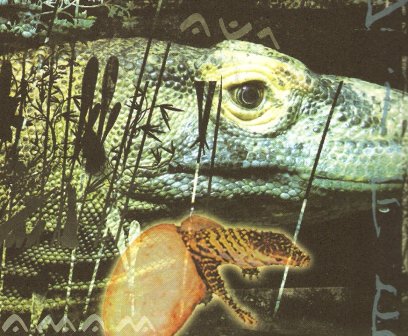
Excerpt from Parthenogenesis (2009) by Theresa Sauer. For da’uli da’uli and an unspecified number of female voices.
The title refers to the Komodo dragon’s ability to reproduce without the aid of males. The piece is intended for da’uli da’uli (an instrument that is struck) and female vocalists singing in Bugis (a language of Komodo Island). Sauer chooses to give a fairly detailed description of the inspiration for the piece, and some rudimentary instructions on how to interpret the score for improvisation.
Although no piece in the collection is “typical” of the others, Sauer’s piece, like many of the others, has an inherent visual beauty independent of its function as a guide to the performing musicians. Someone seeing (not hearing) the work on its own, with no explanation, would be at pains to decipher its pragmatic role. Sauer’s instructions and description serve as a guideline of her intent (e.g. “the vertical lines should intuitively guide the strikes of the da’uli da’uli”), but no one “reading” her score can predict how the music will sound. Granted that this is partly due to the improvisational nature of the piece, but herein lies a major difference from the notations used in the anthology and a more standardized form of notation. Remember my friend’s grandfather who read scores? He could hear an orchestra playing in his mind’s ear. I am a musician, but I don’t read music (or I don’t read it very well anyways). Apparently learning to sight read music is not so difficult a skill to learn – and even those that don’t have the skill can imagine what it is like. If you are having trouble imagining it – watch this animation of John Coltrane’s Giant Steps:
http://www.youtube.com/watch?v=2kotK9FNEYU
But many of the scores in Notations 21 rely on an intuitive rather than literal translation from the notation to the music.
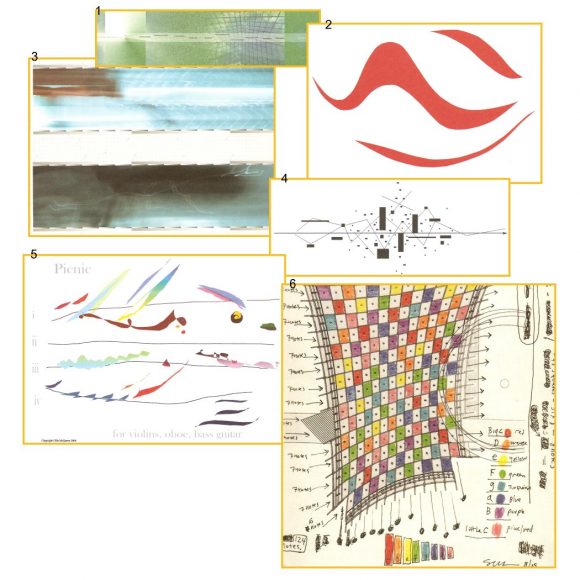
1. Excerpt from Versus (1997) by Kerry John Andrews. For solo voice and piano. Andrews is a visual artist whose scores explore, amongst other things, linear time and stasis. The excerpt above is the vocal part while the piano part is in traditional notation.
2. Excerpt from Museik No. 9 (1979) by Henrik Colding-Jorgensen. For any instrumentation. The word “Museik” is a combination of the Danish words for “museum” and “music”. This series was originally conceived for very young instrumentalists.
3. Excerpt from Das Licht im Dunkel der Wolke (2006) by Peter Hölscher.
4. Excerpt from Paprika King (1996) by Joe Pignato. For any number of improvisers.
5. Excerpt from Picnic (2006) by Cilla McQueen. For violins, oboe, and bass guitar. A poem beginning “Two violins, the first smelling of roses, the second holding a sword” guides the piece.
6. Excerpt from “mapping space in sound” itself from Pavilion Scores 1-5 (2005-2006) by Steve Roden. For children’s glockenspiel. Created as a site-specific work for the Serpentine Gallery’s Summer Pavilion – mirroring the architectural construction of the space. In this case the colours guide the set notes but timing etc. is up to the performers.
This intuitive process of interpretation might be akin to the musical synesthete seeing music, except in reverse, and thus hearing pictures. Perhaps my friend would play more sharps during the brighter parts of some of these notations. It is more likely that each musician, when left to interpret such a visual notation uses personal metaphors to translate the score.
Many other composers decided to subvert more familiar notational forms playing with either the visual aesthetic of such notation or the semantic notions.
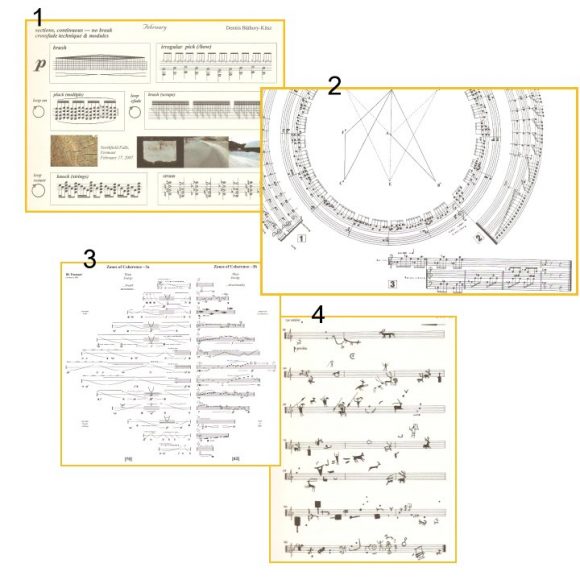
1. Excerpt from Lunar Cascade in Serial Time (2009) by Dennis Báthory-Kitsz. For tenor guitar. In the essay accompanying the piece the composer writes “Music notation engenders disagreement and passion because it is so tightly bound to legibility, meaning, and especially physicality”.
2. Excerpt from “DreamFrame” itself from Five Terrestrial Projections for Guitar and Other Instruments (1989) by Joe Catalano. For guitar alone. The graphic content is a reworking of celestial diagrams by Ptolemy, Copernicus, and Kepler.
3. Excerpt from Zones of Coherence (2003) by David Rosenboom. For trumpet virtuoso. In the detailed essay accompanying the piece the composer writes “The title refers to how zones of musical meaning emerge from a form in which the parts are modular….”
4. Excerpt from Val Comonica: animali (2002) by David Young. For solo violin. In the detailed instruction to the violinist the composer writes “While by its very nature this notation has many freedoms, every attempt should be made to realize the graphics’ contours and shapes as carefully as possible”
Other composers have chosen to make the medium a game where musicians can improvise in a playful manner.
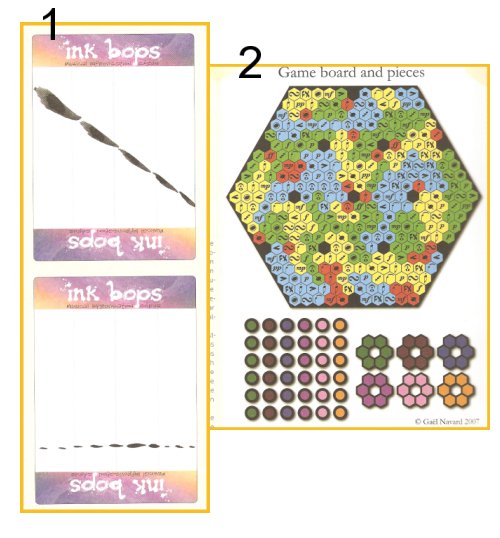
1. Excerpt from Ink Bops (2000/2007) by Ellen Burr. To be played alone or in a group, Ink Bops are musical improvisation cards presented on a poker-deck size of 56 customized cards.
2. Excerpt from Hexagonie (2007) by Gaël Navard. A musical game for 2, 3, 4, or 6 players. The composer writes “the score itself is…mobile because it evolves in real-time with the game.”
Still others have chosen a more technical interpretation when creating a score.
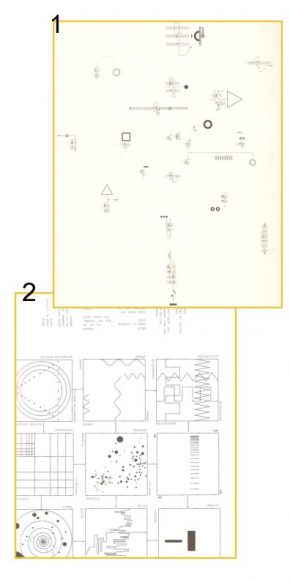
1. Excerpt from “Graphic Score Number 9” itself from 21 Graphic Scores (2001) by Mike Langford. For tape and computer. The methodology of creating the scores originally begun in a technical drawing class this excerpt is based on a tape of birds singing and a Fibonacci spiral.
2. Excerpt from Grid (2002) by Vagn E. Olsson. For variable instrumentation. The composer states “Every section/square in the compositions can be rearranged and played in any order whatsoever.”
Obviously with the enormous range of composers and works included in this book it is impossible to give more than a meagre taste of the wide range of notations included within. Interestingly, many of the composers cite John Cage as an influence in their work and a piece of his own is included in the collection. Sauer is also respectful of Cage’s original method, for example revealing the composers in alphabetical order rather than by any particular theme. The presentation of the scores is also true to the spirit of Alison Knowles montage-type presentation in the original Cage collection, but it is definitely more stylized in 2009. The book is well indexed including composer biographies listed at the end.
Although the collection was apparently put together in a matter of months I feel it would take me much, much longer to fully reflect upon and absorb the works within….I have yet to attempt performing any of the pieces. But to leisurely wander through these scores is a pleasure – picking up on themes and ideas by chance with a random flip of the page. Incorporating chance into art was a constant theme in John Cage’s work, and it is probably appropriate to end with a quotation from the preface of his original anthology. Although he is talking about the way in which pieces of text accompanying the notations were truncated by chance – I think it also applies to the mind-frame when exploring these scores:
A precedent for the absence of information which characterizes this book is the contemporary aquarium (no longer a dark hallway with each species in its own illuminated tank separated from the others and named in Latin): a large glass house with all the fish in it swimming as in an ocean (Ref 2).
More information (and more complete images!):
p.s. For a similar exploration of notation and composition that is local – check out Hearing/Visions/Sonores – an exhibit of contemporary Quebec music composers who incorporate notation and improvisation into their work.
http://www.improvcommunity.ca/hvs/home_eng.html
References
1. Sacks, Oliver. Musicophilia: Tales of Music and the Brain. Revised and expanded. Toronto: Random House of Canada, 2008.
2. Cage, John and Knowles, Alison, Notations. New York: Something Else Press, 1969.
3. John Cage (1912-1992) Collection. Series II. Notations Project p. 1. <http://www.library.northwestern.edu/music/archival-collections/Cage-Series2-Notations.pdf>. Accessed August 2009.
4. John Cage Collection Northwestern University Music Library <http://www.library.northwestern.edu/music/archival-collections/cage.html>.








